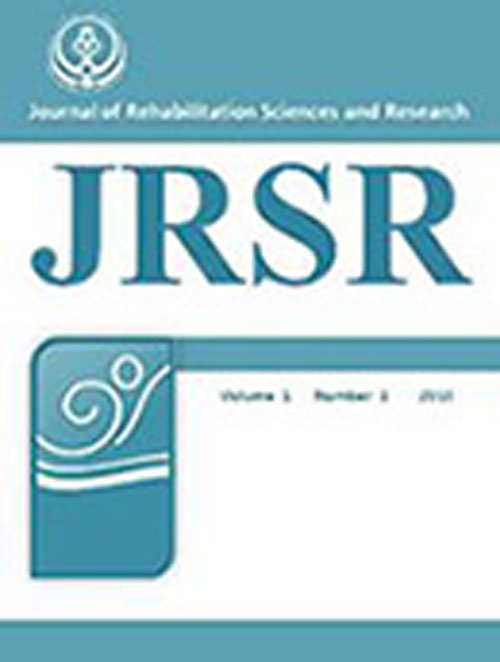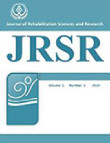فهرست مطالب

Journal of Rehabilitation Sciences and Research
Volume:9 Issue: 2, Jun 2022
- تاریخ انتشار: 1401/04/25
- تعداد عناوین: 8
-
-
Pages 55-56Background
This article aims to investigate the possibility of adapting the spinal circuits and the spinal cord in response to various eccentric, concentric, isometric, balance, and skill exercises, whether these changes are permanent or temporary.
MethodsA narrative review of studies conducted in the field of spinal adaptation following exercise training in Google scholar, Pedro, PubMed, Science direct, Cochrane, Scopus, SID databases in the period of 2000 to 2020 with the keywords: neural adaptation, spinal adaptation, exercise training, neuroplasticity, neuro-rehabilitation, spinal plasticity, eccentric training, isometric training, and concentric training was done. An effort was made to identify and examine research linked to exercise treatment and physiotherapy in healthy and sick persons from among the different studies in this topic.
Resultsfrom 35 recruited articles, 12 articles were critically reviewed and reported in two contents: 1-Spinal adaptation and balance exercises -2- Spinal adaptation and isometric, concentric, and eccentric exercises
ConclusionFrom this review, it can be concluded that the spinal network is fully adaptable, and the manner of this adaptation is completely dependent on training and motor function. The possibility and need of therapeutic application of the spinal plasticity phenomenon in the rehabilitation program of persons with neurological diseases such as stroke are underlined in people with neurological pathologies such as stroke.
Keywords: neural adaptation, spinal adaptation, Exercise Training, Neuroplasticity -
Pages 60-64BackgroundKnee osteoarthritis (KOA) is a common public health disease with an increasing prevalence. It is one of the leading causes of disability, especially in the elderly. Intra-articular hypertonic dextrose prolotherapy is one of the therapies used for KOA. There have been some articles indicating that patients receiving intra-articular normal saline as a control group of the article had improvement as well. The aim of this randomized clinical trial study was to evaluate the efficacy of intra-articular hypertonic saline in comparison with hypertonic dextrose prolotherapy in treatment of KOA.MethodsA total of 54 patients with KOA were randomized in two groups: hypertonic dextrose (28 patients) and hypertonic saline groups (26 patients). All patients received three intra-articular injections of either hypertonic dextrose or hypertonic saline at two weeks intervals. The values obtained by visual analogue pain scale (VAS), Oxford knee scale (OKS), and Western Ontario McMaster University Osteoarthritis Index (WOMAC) questionnaire were the outcome measures which were evaluated before, as well as 2 and 4 weeks after the injections. The data were analyzed using t-test and repeated measurement tests.ResultsBoth groups revealed improvements in outcome measures after 2 and 4 weeks of intervention. However, no statistically significant difference was found between the two groups.ConclusionWe concluded that the intra-articular injection of hypertonic dextrose and hypertonic saline are both effective in the management of KOA. Hypertonic saline can be considered as another medical agent in management of KOA. However, further studies are suggested to evaluate its long-term effects.Keywords: Dextrose, hypertonic saline solution, intra-articular injection, Knee Osteoarthritis
-
Pages 65-71Background
Satisfaction with orthotic devices and services results in more significant orthotic usage. Evaluation of users’ satisfaction could enhance the quality of service delivery. This study aimed to identify the predictive value of demographic factors on users’ satisfaction with lower-limb orthoses and related services.
MethodsThis study was a cross-sectional one. Ninety-seven users of lower-limb orthoses LLO participated in this cross-sectional study. Users’ satisfaction was evaluated with the Orthotic & Prosthetic Users’ Survey (OPUS). SPSS version 22 using linear regression test was used to identify which demographic variables explain variation in satisfaction with LLO and services.
ResultsAccording to linear regression, the variance of satisfaction with the device was significantly explained by the income level and the type of orthosis (P <0.05). However, the predictive value of these variables was relatively low (Adjusted R2 = 0.118). The results also showed that the variance of satisfaction with services was significantly explained by none of the dependent demographic variables (P> 0.05), and the prediction of the independent variable by the demographic variables was very low (Adjusted R2 = 0.063).
ConclusionOrthotists should focus more on clients with low-income to acquire their satisfaction with devices and services. To satisfy their users, they also need to be more careful when making long orthoses such as Knee Ankle Foot Orthosis or Hip Knee Ankle Foot Orthosis.
Keywords: Lower Extremity, Orthotic Devices, patient satisfaction, Linear Regression -
Pages 72-78Backgroundon the one hand, very limited studies were performed on identifying the active regions during swallowing among healthy individuals and those with dementia. On the other hand, to the best of our knowledge, no research has yet compared the injured areas in the brain of patients with dementia with and without dysphagia, such that damage to specific regions in dementia causes dysphagia may be found using this approach. The present study was performed to evaluate the atrophic changes in the internal temporal lobe (hippocampus), frontal (anterior cingulate cortex), and parietal (posterior cingulate cortex), and insula cortex in these patients.Methodsthe present study is a retrospective cross-sectional study. 54 patients with dementia were investigated. The data were collected using a checklist, including information related to the dysphagia, and the brain MRI findings to determine atrophy. The extent of atrophic changes was recorded in the checklist using the median temporal lobe atrophy (MTA) score, Koedem score scale, and the global cortical atrophy (GCA) scale. To present the results, descriptive statistics, and data comparison, chi-square tests were used.ResultsThe mean age of the examined patients was 72.01 with a standard deviation of 10.64 years, and range of 50-95 years. Out of them, 32 (59.3%) were male, and 22 (40.7%) were female. The degree atrophy of hippocampus (p=0.12), frontal lobe (P=0.46), parietal lobe (P=0.83), and insular cortex (P=0.91) in the patients with and without dysphagia did not show significant differences. The frequency distribution of the degree of atrophy based on the site of the development of atrophy was significant in the patients with dysphagia (P=0.033).ConclusionIn general, the findings showed that individuals with dementia who had dysphagia had more hippocampal and frontal lobe (and anterior cingulate) atrophy than dementia patients who did not have this impairment.Keywords: Dementia, Swallowing Disorders, Atrophy, MRI
-
Pages 79-83Background
This study aimed to investigate the impact of frequency and word length on the eye movements in dyslexic students while they were reading Persian textbooks.
MethodsThe method applied to this study was quasi-experimental. The statistical population consisted of 56 male and female students in first, second, and third grades, referring to Learning Disorder Centers of Educational Organization in 2 and 10 districts in Tehran. Twenty-five students with dyslexia were selected using the available sampling method (participants included 12 boys and 13 girls who were in second, third, fourth, and fifth grade with 6, 8, 8, and 3 students, respectively). The eye-tracking device, SMI-RED-120Hz, was used for data collection. The multivariate analysis of variance (MANOVA) method was applied to analyze the data.
ResultsThere are two significant findings the effect of words' length on the number of fixation, fixation time, and the number of regression, as well as the effect of words' frequency on the number of fixation, fixation time, and the number of regressions.
ConclusionFrequency and word length on fixation and regression play an important role in the process of reading in dyslexic students.
Keywords: Dyslexia, Eye Tracking, Features Text, Fixation, Regression, Students -
Pages 84-88Background
This study aimed to prepare the Persian version of Speech, Spatial, and Qualities of Hearing Scale questionnaire-12 (SSQ-12-Persian version) and assess its validity and reliability to facilitate the effect of the usage of hearing aids on individuals using them.
MethodsThis study is considered an original research type of article. The questionnaire was translated to Persian according to WHO method. Firstly, two fluent Persian-speaking translators translated the questionnaire from Persian to English, and then three audiologists examined the questionnaire. The questionnaire was then translated from Persian to English and conceptually reviewed by two bilingual translators. Finally, 99 senior persons aged 22 to 52 years who used hearing aids and had their hearing thresholds assessed lately were given the Persian version of the Speech, Spatial, and Qualities of Hearing Scale 12 (SSQ-12) questionnaire. T-test examination and Cronbach Alpha were used to assess the reliability and validity and test-retest reliability.
ResultsPersian version of the SSQ-12 questionnaire showed high internal consistency (assessed by Cronbach Alpha = 0.924) and high test-retest (assessed by Cronbach Alpha = 0.868) reliability.
ConclusionSSQ-12 questionnaire is a comprehensive summary of the SSQ-49 questionnaire. It would be one of the valid questionnaires to evaluate hearing performance improvement in hearing aids users. The paired sample t-test revealed that the Persian version of the SSQ-12 questionnaire has good reliability and validity, and Cronbach's alpha revealed that the questionnaire has strong internal consistency (Cronbach's alpha =0.924).The reliability of the test-retest after a month was obtained, and the total scale result was 0.867. According to this study's results, SSQ-12 can be used as other Persian translated questionnaires like GHABP, SHQ, and IOI-HA for examining the effectiveness of hearing aids and their effects on limiting disabilities related to hearing loss.
Keywords: Questionnaire, Validity, reliability, WHO -
Pages 89-92BackgroundCOVID-19 could induce vestibular neuritis in some patients, and there is limited information on their vestibular evaluation and rehabilitation.MethodsThree cases infected by COVID-19-induced vestibular neuritis underwent vestibular evaluation and rehabilitation. They showed unilateral dysfunction in caloric and video head impulse tests. A home-based vestibular rehabilitation (VR) was used for their treatment.ResultsAlthough the symptoms in one patient significantly improved, she still had a mild episode of vertigo. The other two patients completely recovered. They also had no remaining vertigo or imbalance at the end of VR. The final physical examinations were normal, and the total score onthe Dizziness Handicap Inventory showed no handicapping.ConclusionVR could be effective in the management of COVID-19-induced vestibular neuritis. So, we could expect a good recovery similar to other disorders with unilateral vestibular hypo-function.Keywords: Vestibular, Vestibular rehabilitation, COVID-19, vestibular neuritis
-
Pages 93-96Background
Covid-19 was reported in China for the first time. The most common manifestation of this novel infection is respiratory problems. However, it can also invade both central and peripheral nervous systems. The usual central nervous system complications were dizziness (16.8%) and headache (13.1%). The most common reported symptoms in patients with peripheral nervous system problems were taste impairment (5.6%) and smelling impairment (5.1%) due to olfactory nerve involvement.
MethodsWe present a 46-year-old male who was referred to our clinic in Shiraz for electrodiagnosis and better evaluation due to paresthesia and numbness of the right 4th and 5th fingers accompanied by weakness and atrophy of the muscles in the ulnar nerve territory, which occurred during Covid-19 infection in this patient.
ResultsSevere partial involvement of the right ulnar nerve at the elbow region was detected in the electrodiagnosis, and findings in the right elbow MRI favored ulnar neuritis.
ConclusionFocal neuritis of the ulnar nerve (ulnar mononeuropathy) seemed to be a new presentation of peripheral nervous system involvement in COVID-19 disease.
Keywords: COVID-19, peripheral nervous system, ulnar nerve disease


